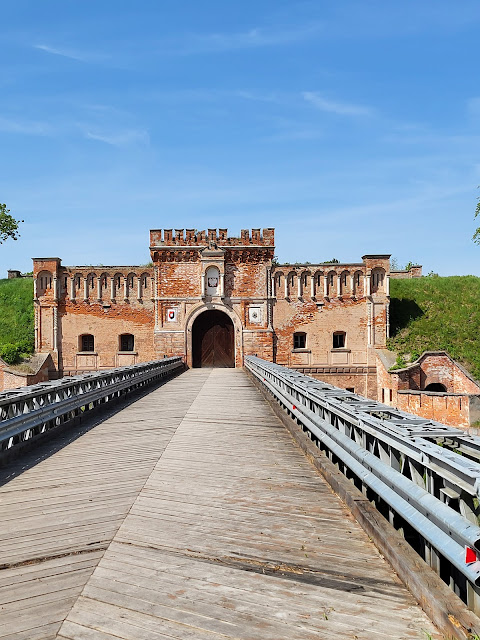Brama lubelska to jedna z dwu paradnych bram do Twierdzy Dęblin. Wzniesiono ją wraz z cała cytadelą za panowania cara Mikołaja I Romanowa po stłumieniu powstania listopadowego. Wraz z twierdzami: cytadelą w Warszawie i Modlinie (Nowogieorgiewsk), twierdza dęblińska (nazwano ją Iwangorod) składały się na system trzymający w ryzach niepokorny kraj nad Wisłą. Budowę twierdzy w Dęblinie rozpoczęto w 1838 roku na podstawie projektu wybitnego inżyniera, specjalisty od fortyfikacji, generała Iwana Dehna.
Brama Lubelska powstała wraz z głównymi wałami twierdzy i stanowiła wejście do jej wnętrza od strony południowej. Jej bryła jest murowana z cegły, ma dwie kondygnacje. Elewacja frontowa prezentuje stylu neoromański. Dekorowana jest elementami z cegły profilowanej i kamienia: ryzalitami i arkadowymi podcieniami wspartymi na kolumnach.
The Lublin Gate is one of the two parade gates to the Deblin Fortress. It was erected, together with the entire citadel, during the reign of Tsar Nicholas I Romanov after the suppression of the November Uprising. Together with the fortresses: the citadel in Warsaw and Modlin (Nowogieorgiewsk), the Dęblin Fortress (named Ivangorod) comprised a system keeping the unruly country on the Vistula in check. Construction of the Dęblin fortress began in 1838, based on a design by the eminent engineer, a specialist in fortifications, General Ivan Dehn.
The Lubelska Gate was built together with the main ramparts of the fortress and constituted the entrance to its interior from the southern side. Its body is made of brick and has two storeys. The front elevation presents a Neo-Romanesque style. It is decorated with moulded brick and stone elements: risalits and arcades supported by columns.
Das Lubliner Tor ist eines der beiden Parade-Tore der Festung Deblin. Es wurde, wie die gesamte Zitadelle, während der Herrschaft von Zar Nikolaus I. Romanow nach der Niederschlagung des Novemberaufstandes errichtet. Zusammen mit den Festungen - der Zitadelle in Warschau und Modlin (Nowogieorgiewsk) - bildete die Festung Dęblin (genannt Iwangorod) ein System, das das widerspenstige Land an der Weichsel in Schach hielt. Der Bau der Festung Dęblin begann 1838 nach einem Entwurf des bedeutenden Ingenieurs und Festungsspezialisten General Iwan Dehn.
Das Lubelska-Tor wurde zusammen mit den Hauptmauern der Festung errichtet und bildete den Zugang zum Inneren der Festung von der Südseite her. Es besteht aus Backstein und hat zwei Stockwerke. Die Fassade ist im neoromanischen Stil gehalten. Sie ist mit geformten Ziegel- und Steinelementen verziert: Risalite und von Säulen getragene Arkaden.





Brak komentarzy:
Prześlij komentarz